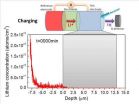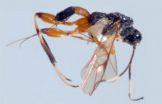(Press-News.org) The information encoded in our genes is translated into proteins, which ultimately mediate biological functions in an organism. Messenger RNA (mRNA) plays an important role, as it is the molecular template used for translation. Scientists from the Helmholtz Zentrum Muenchen and the Technische Universität Muenchen, in collaboration with international colleagues, have now unraveled a molecular mechanism of mRNA recognition, which is essential for understanding differential gene regulation in male and female organisms. The results are published in the renowned scientific journal Nature.
The number of genes in humans, mice and fruit flies is almost identical, around 20.000, and thus cannot explain the phenotypic differences between these organisms. Thus, for the evolution of life not only the number of genes but also the regulation of these genes plays a critical role. Upon transcription of the DNA, mRNA is produced as an initial step, which subsequently functions as template for the synthesis of proteins. Protein synthesis is regulated by the binding of regulatory proteins to the mRNA. How these proteins specifically recognize the RNA has been poorly understood to date.
An international team, led by Helmholtz Zentrum München (HMGU) and Technische Universität München (TUM), has now determined the three-dimensional structure of such a regulatory protein-RNA-complex. Crystallography and NMR spectroscopy analysis performed by the Munich team was complemented with small angle scattering data performed at the Institut Laue Langevin in Grenoble. The scientists studied the specific complex formed between the regulatory proteins Sxl (Sex-lethal) and Unr (Upstream-of-N-Ras) with mRNA in the fruit fly model. This protein complex is essential to ensure that the expression of genes located on the two female (XX) X-chromosomes equals that of genes located on the single male (XY) X-chromosome. This guarantees that comparable protein concentrations are achieved in both sexes, which is essential for viability of fruit flies.
A paradigm for gene regulation
The three-dimensional structure now reveals how multiple proteins collaborate for highly specific recognition of the mRNA. "Our results represent a paradigm for the regulation of various essential cellular processes at the level of mRNA", explains Sattler, director of the Institute of Structural Biology at HMGU. The specific recognition of mRNA is achieved by cooperation of several RNA-binding proteins, even though these proteins individually exhibit poor binding affinity and are involved in distinct processes in the cell. By combining multiple proteins, the number and variety of biological processes that can be regulated by a relatively small number of regulatory RNA binding proteins, is greatly expanded.
The authors expect that this principle represents an essential and widespread mechanism of gene regulation in higher organisms, where mutation or misregulation of homologous proteins has been implicated in disease.
INFORMATION:
The research was conducted by a group of scientists around Dr. Janosch Hennig, Dr. Grzegorz Popowicz and Professor Dr. Michael Sattler from Helmholtz Zentrum München (HMGU) and Technische Universität München (TUM) together with the group of Dr. Fátima Gebauer at the Centre for Genomic Regulation (Barcelona, Spain). X-ray crystallography and NMR* spectroscopy experiments were performed at the Institute of Structural Biology of HMGU and the Bavarian NMR Centre (TUM und HMGU), small angle scattering was done by Dr. Frank Gabel at the Institut Laue-Langevin and the Institut Biologie Structurale (Grenoble, France).
Further Information
* NMR= Nuclear Magnetic Resonance
Original publication:
Hennig, J. et al. (2014). Structural basis for the assembly of the SXL-UNR translation regulatory complex, Nature, doi: 10.1038/nature13693
Link to publication: http://www.nature.com/nature/journal/vaop/ncurrent/full/nature13693.html
Helmholtz Zentrum München, as German Research Center for Environmental Health, pursues the goal of developing personalized medical approaches for the diagnosis, treatment and prevention of major widespread diseases such as diabetes mellitus and lung diseases. To achieve this, it investigates the interaction of genetics, environmental factors and lifestyle. The head office of the Center is located in Neuherberg in the north of Munich. Helmholtz Zentrum München has a staff of about 2,200 people and is a member of the Helmholtz Association, a community of 18 scientific-technical and medical-biological research centers with a total of about 34,000 staff members. http://www.helmholtz-muenchen.de
The Institute for Structural Biology (STB) investigates the spatial structures of biological macromolecules, their molecular interactions and dynamics using integrated structural biology by combining X-ray crystallography, NMR-spectroscopy and other methods. Researchers at STB also develop NMR spectroscopy methods for these studies. The goal is to unravel the structural and molecular mechanisms underlying biological function and their impairment in disease. The structural information is used for the rational design and development of small molecular inhibitors in combination with chemical biology approaches.
Technische Universität München (TUM) is one of Europe's leading research universities, with around 500 professors, 10,000 academic and non-academic staff, and 36,000 students. Its focus areas are the engineering sciences, natural sciences, life sciences and medicine, reinforced by schools of management and education. TUM acts as an entrepreneurial university that promotes talents and creates value for society. In that it profits from having strong partners in science and industry. It is represented worldwide with a campus in Singapore as well as offices in Beijing, Brussels, Cairo, Mumbai, and São Paulo. Nobel Prize winners and inventors such as Rudolf Diesel and Carl von Linde have done research at TUM. In 2006 and 2012 it won recognition as a German "Excellence University." In international rankings, it regularly places among the best universities in Germany. http://www.tum.de
New mechanism in gene regulation revealed
2014-09-08
ELSE PRESS RELEASES FROM THIS DATE:
Researchers part water
2014-09-08
Using an "electric prism", scientists have found a new way of separating water molecules that differ only in their nuclear spin states and, under normal conditions, do not part ways. Since water is such a fundamental molecule in the universe, the recent study may impact a multitude of research areas ranging from biology to astrophysics. The research team from the Center for Free-Electron Laser Science (CFEL) – a collaboration of DESY, the Max Planck Society and Universität Hamburg – reported its results in the journal Angewandte Chemie International Edition.
At first ...
Simeprevir in hepatitis C: Added benefit for certain patients
2014-09-08
The drug simeprevir (trade name: Olysio) has been available since May 2014 for the treatment of adult patients with chronic hepatitis C infection. In an early benefit assessment pursuant to the Act on the Reform of the Market for Medicinal Products (AMNOG), the German Institute for Quality and Efficiency in Health Care (IQWiG) examined whether this new drug offers an added benefit over the appropriate comparator therapy.
The drug manufacturer dossier provided indications and hints of an added benefit of simeprevir when the patients infected with hepatitis C virus (HCV) ...
Plant diversity in China vital for global food security
2014-09-08
With climate change threatening global food supplies, new research claims the rich flora of China could be crucial to underpin food security in the future.
A team from the University of Birmingham and partners in China have identified 871 wild plant species native to China that have the potential to adapt and maintain 28 globally important crops, including rice, wheat, soybean, sorghum, banana, apple, citrus fruits, grape, stone fruits and millet. 42% of these wild plant species, known as crop wild relatives (CWR) occur nowhere else in the world.
CWR are wild plant ...
Plant insights could help develop crops for changing climates
2014-09-08
Crops that thrive in changing climates could be developed more easily, thanks to fresh insights into plant growth.
A new computer model that shows how plants grow under varying conditions could help scientists develop varieties likely to grow well in future.
Scientists built the model to investigate how variations in light, day length, temperature and carbon dioxide in the atmosphere influence the biological pathways that control growth and flowering in plants.
They found differences in the way some plant varieties distribute nutrients under varying conditions, ...
First-ever look inside a working lithium-ion battery
2014-09-08
VIDEO:
Using a neutron beam, chemists and engineers at The Ohio State University were able to track the flow of lithium atoms into and out of an electrode in real time...
Click here for more information.
COLUMBUS, Ohio—For the first time, researchers have been able to open a kind of window into the inner workings of a lithium-ion battery.
Using a neutron beam, chemists and engineers at The Ohio State University were able to track the flow of lithium atoms into and out ...
Targeted immune booster removes toxic proteins in mouse model of Alzheimer's disease
2014-09-08
Alzheimer's disease experts at NYU Langone Medical Center and elsewhere are reporting success in specifically harnessing a mouse's immune system to attack and remove the buildup of toxic proteins in the brain that are markers of the deadly neurodegenerative disease.
Reporting on their experiments in the journal Acta Neuropathologica Communications online Sept. 3, the researchers say the work advances the development of more effective clinical treatments for Alzheimer's because their immune booster reduced both amyloid beta plaques and tau tangles. Previous immunomodulatory ...
Nearly half of older adults have care needs
2014-09-08
Nearly half of older adults – 18 million people—have difficulty or get help with daily activities, according to a new study.
Researchers from the University of Michigan and the Urban Institute analyzed data from a national sample of older adults drawn from Medicare enrollment files. In all, 8,245 people were included in the 2011 the National Health and Aging Trends Study. The analysis was published in the current (September 2014) issue of the Milbank Memorial Quarterly.
"Although 51 percent reported having no difficulty in the previous month, 29 percent reported receiving ...
The future of our crops is at risk in conflict zones, say Birmingham scientists
2014-09-08
Wild species related to our crops which are crucial as potential future food resources have been identified by University of Birmingham scientists, however, a significant proportion are found in conflict zones in the Middle East, where their conservation is increasingly comprised.
The scientists have identified 'hotspots' around the globe where crop wild relatives (CWR) – species closely related to our crops which are needed for future crop variety development – could be conserved in the wild in order to secure future global food resources.
The hotspot where CWR ...
New parasitoid wasp species found in China
2014-09-08
For the first time, wasps in the genus Spasskia (family: Braconidae) have been found in China, according to an article in the open-access Journal of Insect Science. In addition, a species in that genus which is totally new to science was also discovered.
The new species, Spasskia brevicarinata, is very small — male and female adults are less than one centimeter long. It is similar to a previously described species called Spasskia indica, but the ridges on some of its body segments are different. In fact, the species epithet brevicarinata reflects a short ridge on its ...
Unusual immune cell needed to prevent oral thrush, Pitt researchers find
2014-09-08
PITTSBURGH, Sept. 8 – An unusual kind of immune cell in the tongue appears to play a pivotal role in the prevention of thrush, according to the researchers at the University of Pittsburgh School of Medicine who discovered them. The findings, published online today in the Journal of Experimental Medicine, might shed light on why people infected with HIV or who have other immune system impairments are more susceptible to the oral yeast infection.
Oral thrush is caused by an overgrowth of a normally present fungus called Candida albicans, which leads to painful white lesions ...


